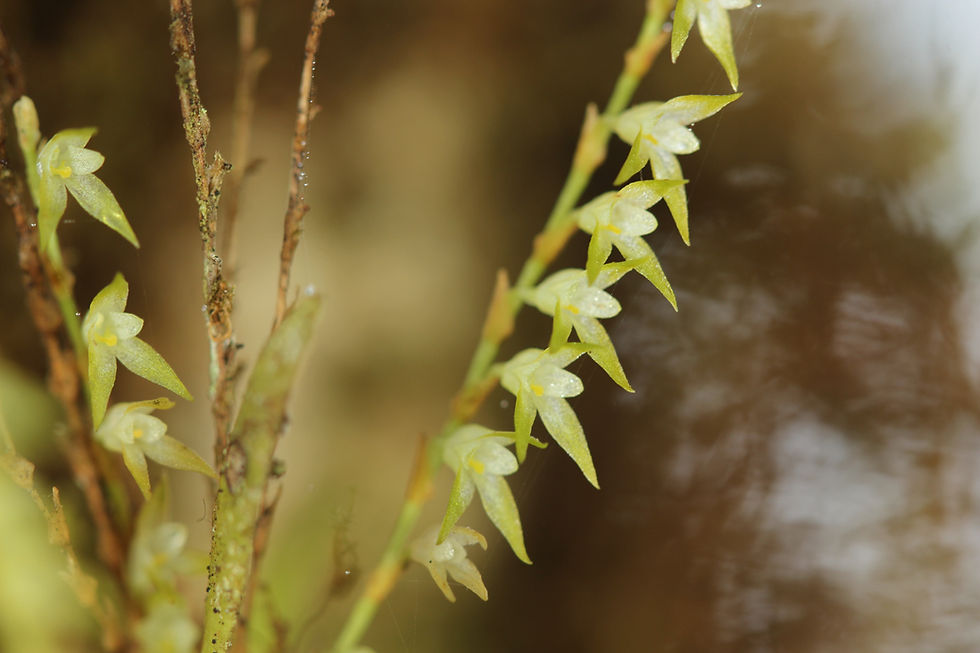Plants, more plants
- Tropiscape Orchids
- Jun 10, 2019
- 3 min read
That’s what I got as a response from Davina when I asked her what the title of this post should be. Great, thanks for that. Honestly, she’s feeling ill and we’re hoping it’s not the flu. Our guide Ivan is very worried and got her to drink a hot herbal orange juice, just in case…
But enough of that, back to the orchids.
Day 9 – Zumba to Amaluza
We try to diversify from orchids, but it’s not easy. So here’s a bird. An ecuatorian swallow, cool huh?

And now onto the matter at hands. Sobralia virginalis along the road! We saw dozens of those, pretty white if you ask me.
A big one, first Phragmipedium in bloom! Not our kind of orchids, but it’s still impressive seeing this Phragmipedium czerwiakonianum in-situ. I mean…where the hell is this growing? In rockish ground in full sunlight. Whut?
This was interesting to see on the side of the road…why not go and have a look?

Well, it definitely paid off. It’s starting to feel like it’s too easy spotting miniature orchids in Ecuador. I mean, seriously…Brachondinium sp., Platystele sp. and Oncidium abortivum after just a 10 min walk.
Aha! Another non-orchid picture from the same location: Utricularia sp. Yes, they have epiphyte Utricularia here, very cool indeed! Another big one as well that we found later in the day.
And this branch just filled with Elaphoglossum peltatum, wonderful! Hopefully we’ll have a clump that size in the future.

And then…our second frog ever in Ecuador. Weird right? But there aren’t much of them at the altitudes we’re at right now.

Afterwards, we suddenly decided to stop at a group of small trees and yes, you’ve guessed it: orchids! And not just any orchid…Lepanthes calophlebia to be precise! I can just keep looking at it and smile.

Last but one stop: An impressive Lepanthes sp., a very large-sized Lepanthes with unusual flowers. And further on the one and only Lepanthes gargantua.
And now for the last stop of the day, which ended up being the best one (we’re coming back here first thing in the morning as there wasn’t enough time to check everything). Some large Pleurothallis sp., a small unknown sp., an extremely eye pleasing Specklinia sp. and this almost terrestrial Lepanthes ictalurus with amazing leaves and flowers! And last one: Pleurothallis secunda in-situ!
Finishing up with a huge moth at the restaurant of our hotel in Amaluza.

Day 10 – Zumba to Amaluza (again)
Yes, again. After all the nice things we saw, we didn’t have time to do the whole route we had planned so we went back to our last spot.
Maybe not such a good call after all, this was about the harshest day so far. Cold, windy and constant light rain…dead-tired after such a day. But! Orchids nonetheless.
First, this tiny (and first) Pinguicula sp. we spotted. Very cute!

Oh, today (of all days, of course, with all the rain) I decided to take out the 100mm macro lens. Some success, at least until the first rains hit. This cute and very dry, sunny growing Epidendrum sp. was the perfect subject for a few tries. Not bad?
Further on (and wetter), this shot of a bigger Epidendrum sp. With a bit of distance, this lens is great for taking shots of bigger flowers as well!

As we went back to our last spot, we found our last Lepanthes again. It’s nice to have friends who identify plants for you while you’re in Ecuador 😊 This was now identified as Lepanthes ictalurus, pretty rare! Another macro shot, but not easy with a lot of wind…

This last hurried shot of a mini-miniature is of an unidentified orchid (sorry!). The plant looked like an Epidendrum, but the flowers…not sure. Anyway, cute.

What else, what else…oh right! This huge Lepanthes decurva Yes, a big Lepanthes. I think this is about the biggest Lepanthes we ever saw, 50cm stalks!

And…finally, our first Scaphosepalum sp.! Small, but pretty nonetheless.

Off to sleep now, bloody tired!












































Hope Davina’s feeling better soon—her title choice definitely adds charm to the post! The blend of personal moments and orchid appreciation makes this read feel warm and grounded. Just like nature’s elegance, personal style thrives on thoughtful pairings. For those curating fresh looks, best earrings to pair with white dresses offers a practical guide, featuring refined jewelry pieces like stud earrings that add subtle brilliance and balance to any outfit. A lovely reminder that beauty blooms in many forms!